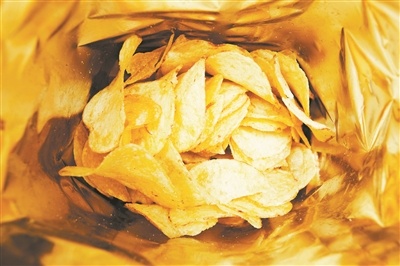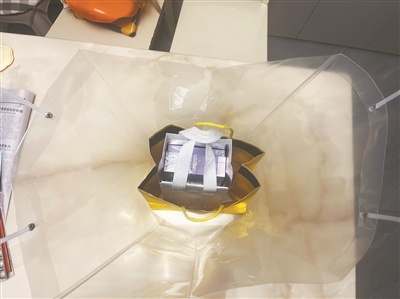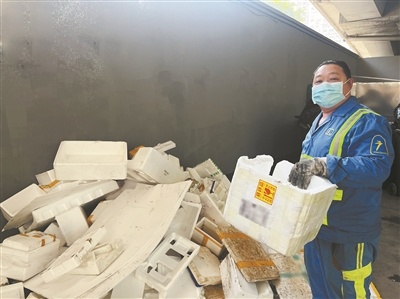Food packaging: too much garbage for sanitation workers to eat.

Expanded foods such as bagged potato chips are also over-packaged. (@ vision china)

The specialty food sold by a merchant is "layered" on the packaging.

In a garbage transfer station, sanitation workers are handling a pile of abandoned foam boxes.
Since September 1, 2023, the mandatory national standard GB23350-2021 "Food and Cosmetics for Restricting Overpackaging of Commodities" (hereinafter referred to as the "new national standard") revised by the State Administration of Market Supervision has been officially implemented, which clearly stipulates the number of packaging layers, packaging cost and packaging void ratio of 31 kinds of food and 16 kinds of cosmetics, including tea. In the past few days, the reporter visited several sanitation stations and garbage transfer stations and learned that over-packaging of food still exists, and most food packaging bags are not recyclable, so they can only be classified as "other garbage" and finally disposed of by incineration, which brings great waste. The commodity packaging that consumers paid for turned out to be the garbage that sanitation workers cleaned up. Should this phenomenon cause reflection? The reporter conducted an investigation and interview on this.
Text, map/Guangzhou Daily all-media reporter Xiao Huanhuan (except signature)
A three-layer package of birthday cake is all non-recyclable garbage except the carton.
At 4 o’clock every morning, when people are still asleep, sanitation worker Luo Xiumei has already got up and started a day’s work.
At 7 o’clock in the morning, at a garbage collection point in Jiangnan Middle Street, Luo Xiumei picked up rubber gloves and sorted the garbage in the trash can for the second time. "Look at this birthday cake box. It has three floors inside and three floors outside, and all the plastic garbage is not recyclable." The reporter saw that this birthday cake box has three layers of packaging, the innermost layer is a plastic bracket, the second layer is a white hard plastic, which plays the role of "shaping" the cake, and the third layer is a beautiful paper box. The reporter visually observed that this cake box is about 30 cm wide.
Luo Xiumei said frankly that this kind of food packaging waste is the most "headache" for sanitation workers. "In addition to the outermost layer of cartons, others are not recyclable. If there is still unfinished cake mixed in the box, we must first dispose of the cake as kitchen waste, then collect the carton as recyclable waste, and then bundle the hard plastic as non-recyclable waste separately. " She told reporters that it often takes four or five minutes to sort out a cake box.
Engaged in sanitation work for many years, Luo Xiumei increasingly felt the workload brought by food over-packaging. "This kind of hard plastic is neither recyclable nor easy to compress, and it is very troublesome to handle. Often two packaging boxes need to occupy a large garbage bag, and sometimes there are more than a dozen cars in this hard plastic packaging box at the end of the day. "
A box of four-layer packaging products of American ginseng tablets accounts for less than 1/5 of the packaging volume.
A garbage transfer station located in Dong Xiao South Road is a large-scale centralized collection and transportation place of domestic garbage in Haizhu District. Journalists can also see all kinds of food packaging waste here. Master Wang, a sanitation worker, opened a packaging box of American ginseng slices. First, there was a layer of velvet cloth, followed by a hard bracket, a plastic box with a concave bottom, and the outermost layer was a hard plastic packaging box. "The product is estimated to be less than 1/5 of the entire packaging volume. Except for a few pieces of American ginseng, everything else should be thrown away as garbage. Velvet cloth like this is non-recyclable garbage. This bracket material is neither glass nor plastic. It may be a synthetic material and cannot be recycled. We can only smash it and take it away as other garbage. "
"We monitor all the more than 200 sanitation workers around the world. Because of the large amount of domestic garbage, we have to clear the road garbage twice a day. Overpackaged food packaging materials like this make sanitation workers miserable." Kong Xiangying, director of Jiangnan Zhongjie City Appearance and Environmental Sanitation Supervision and Inspection Institute, was deeply touched by the over-packaging of food. "Now all kinds of food, tea, nutrition and packaging boxes are too exaggerated, and most of these packaging boxes are not recyclable, so they can only be transported to waste incineration power plants for waste treatment."
Sanitation workers "stand in barrels" overtime, and food packaging waste accounts for about 30% of the daily domestic waste.
Kong Xiangying introduced that Jiangnan Middle Street is located in the prosperous business district of Haizhu District, and there are many kinds of packaged domestic garbage. "The amount of domestic waste that our environmental monitoring institute is responsible for clearing and transporting every day reaches more than 80 tons, and all kinds of food packaging waste account for about 30%."
There are three kinds of food packaging that impressed Kong Xiangying: tea packaging box, moon cake (zongzi) packaging box and nutrition (nourishing) gift box packaging. After various festivals, the food packaging waste to be treated will be doubled than usual, and sanitation workers often have to work overtime from morning until late at night. "Some gift boxes are not only beautifully packaged, but even the individual products in the boxes are packaged in exquisite small plastic boxes, and these hard plastic boxes are not recyclable, and finally they are burned, which is a waste of resources."
Kong Xiangying said that not only the "pool area" of food packaging is getting bigger and bigger, but also some snack packaging, which has increased the burden on front-line sanitation workers. "The so-called’ pool area’ refers to the package void ratio, which refers to the ratio of the necessary space volume occupied by removing the contents in the package to the total volume of the package. According to the new national standard, food packaging should not exceed three layers, and the production organization should take measures to control the cost of all packaging except the packaging that is in direct contact with the inner packaging not to exceed 20% of the product sales. The calculation of packaging voidage requires different requirements according to the different net contents of a single commodity. Take a food with a net content of more than 50mL/g as an example, and its porosity shall not exceed 30%. "
According to this standard, many snack packaging bags collected and transported by Kong Xiangying and his workers at the garbage station are also "exceeding the standard". For example, she said that the big bag of potato chips or puffed food that people often eat is 30 cm long, but the food itself accounts for less than half of the area of the bag. "In order to make food look more’ material’, merchants fill it with air. But this kind of plastic packaging bag can’t be recycled, and it can’t be mixed with other domestic garbage. Every day, just sorting these plastic bags, sanitation workers need to’ stand in the bucket’ for two hours. "
The reporter learned that most of the plastic packaging bags mentioned by Kong Xiangying are made of polyethylene and polyvinyl chloride. The reason why these plastic packaging boxes and plastic bags are not recyclable is that the materials themselves are not degradable, and there are often residues and pollutants on the packaging boxes. The cost of cleaning these waste plastics is often higher than their own value.
In this regard, Pan Yiwen, director of Huazhou Street City Appearance and Environmental Sanitation Supervision Institute, also feels the same way. "Over-packaging of food has increased the daily workload of our sanitation workers by one-third, and sanitation vehicles have to run several times a day." According to Pan Yiwen, the villages under the jurisdiction of Huazhou Street are densely populated. The institute is responsible for clearing and transporting about 150 tons of domestic garbage every day, and food packaging garbage accounts for about 30% of them.
The recycling cost of foam box is high, and the "special-shaped" packaging and composite plastic products are difficult to handle.
In a garbage transfer station on Dong Xiao South Road, dozens of foam boxes stand out. "This kind of foam box is difficult to handle, and enterprises are not willing to accept it and lose money." The sanitation workers at the scene told reporters.
Pan Yiwen said that foam boxes like this are bulky, light in weight and low in recycling value, and there may be thousands of foam boxes thrown away every day in this area. "White foam boxes are recyclable garbage with extremely low value, and in some places they are classified as non-recyclable garbage. Because of their light weight, high transportation cost, they need special venues and compression equipment in the post-treatment process, and the overall disposal cost is extremely high. Like a 5-ton pickup vehicle, it can only collect and transport dozens of kilograms of foam boxes, and the light freight is not a small expense. "
Pan Yiwen also introduced that some food packaging is not only three layers inside and three layers outside like a doll, but also "abnormal" in shape, which is extremely difficult to handle. "For example, the base in the liquor packaging box belongs to a special shape. The base of each liquor is different, and it is a composite plastic product that cannot be recycled, and a layer of hard plastic on the liquor packaging is also recyclable." He said that in many cases, in order to facilitate transportation, sanitation workers even use hammers to break these hard plastics into pieces. When dealing with these "special-shaped" packages, it is also common for sanitation workers to get their hands cut.
Kong Xiangying once visited the waste incineration power plant and understood how difficult it is to treat this kind of plastic waste. "A variety of plastics are often used in a plastic product, and each batch of plastic products needs to add different chemical additives according to different product requirements. Even if the plastic products are recycled, the chemical structure of recycled plastic products is likely to be affected by previous mechanical forces and high temperature treatment, and the performance is greatly reduced." She said that the recycling of plastics is not as simple as putting all the plastics together. In fact, because many plastics are difficult to recycle, the final treatment method is to burn them to generate electricity, but at the same time it will also produce toxic gases and solid particles that pollute the environment.
Take-out also has over-packaging, and nearly ten pieces of single take-out packaging waste.
Wang Fengli, director of the Second Cleaning Office of Tianhe District Urban Management, told the reporter that with the increasing consumption of take-away, some over-packaged take-away also added a burden to sanitation workers. Except for most of the take-away lunch boxes, other packages in the take-away are not recyclable.
A pair of chopsticks, a plastic spoon, a plastic round bowl, a plastic round bowl cover and a plastic bag. If soy sauce, vinegar or other seasonings are added to the user’s order, 3 to 5 small plastic bags will be produced … For such an order, the amount of garbage generated by the user after eating a takeaway meal will be nearly 10 pieces. However, many disposable tableware and lunch boxes distributed by merchants are actually not used by customers. "There are spoons and chopsticks at home. Many of these disposable tableware have been lost on the spot. For sanitation workers, it is very difficult to handle these non-recyclable take-away packaging." Wang Fengli said that because the take-away packaging needs to be dry and wet, many takeaways may be thrown into the trash can before they are finished. Sanitation workers need to clean up the unfinished meals first, and then recycle all parts of the take-away packaging. Take-away lunch boxes, plastic bags, seasoning bags, tableware bags should be classified, and the work area of sanitation workers in this institute includes crowded places like guangzhou east railway station, so the workload of handling take-away packaging can be imagined. "We handle thousands of take-away lunch boxes every day, and we call for less over-packaging." Chen Guangyou, monitor of the East Station of the Second Cleaning Office of Tianhe District Urban Management, said.
insider
Let the national standard "grow teeth" and let enterprises dare not "step on the red line"
Lu Pengyi, director of Guangdong Packaging Technology Association, has been engaged in the packaging industry for more than 20 years, and he also feels the same way about food over-packaging. "Nowadays, the packaging of many foods and gifts can not be described as extravagant and extravagant, which is completely beyond the scope of normal packaging. Excessive packaging causes a lot of garbage pollution, which not only increases the burden on sanitation workers, but also costs consumers."
"Now 70% of the tea, nutrition and snacks on the market are over-packaged." Lu Pengyi said that companies often find him, hoping that in addition to designing food packaging bags more beautifully, they can also design several layers of packaging bags to make them look more luxurious. Every time a guest puts forward such a request, Lu Pengyi will persuade him: "Product packaging only needs to undertake the most basic functions, so it can be transported and carried without pollution. Even if you want to promote the brand through product packaging, you can’t overdo it, otherwise it will damage the image of the enterprise."
Lu Pengyi said that because the relevant food packaging industry standards promulgated by the state many years ago are only recommended standards, unless the products of enterprises are investigated and dealt with on the spot by relevant administrative law enforcement departments, enterprises have no sense of urgency about the problem of excessive packaging of goods. "Take the cost as an example. There is an unwritten rule in the packaging industry that the cost of outer packaging of products does not exceed 20% of the selling price of products. However, many food production enterprises do not hesitate to spend a lot of money on packaging in order to give their own products extra points, such as some tea and tonics. There are three or four layers of light packaging boxes, and the price of packaging boxes far exceeds 20% of the selling price of products. This is in the final analysis because the rigidity of the old standard is not enough. "
According to the new national standard implemented on September 1st last year, commodity producers and operators who produce and operate commodities that do not meet the packaging requirements stipulated in the new national standard shall be ordered by the market supervision and administration department of the local people’s government at or above the county level or relevant departments to make corrections according to relevant laws and regulations, and those who refuse to make corrections shall be fined from 2,000 yuan to 20,000 yuan, and those who are serious shall be fined from 20,000 yuan to 100,000 yuan.
Lu Pengyi said that the key to curb the problem of food over-packaging is to formulate mandatory standards, strengthen the inspection of product packaging law enforcement, make national standards "grow teeth" and impose heavy penalties on enterprises that violate the new national standards, so that enterprises are afraid to "step on the red line" and gradually establish the concept that "simple packaging is fashion". "After enterprises adapt to the new national standard, the problem of food over-packaging is expected to improve."